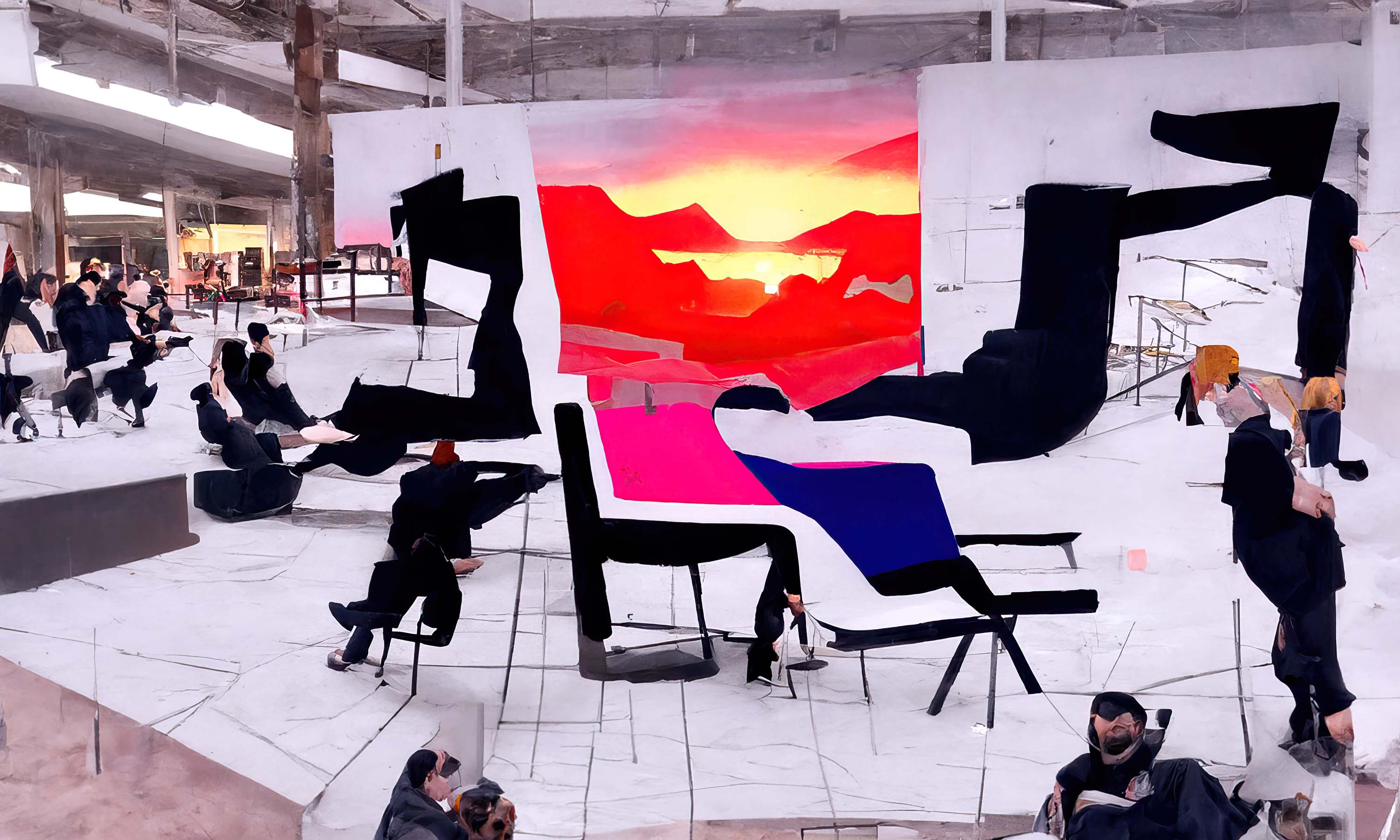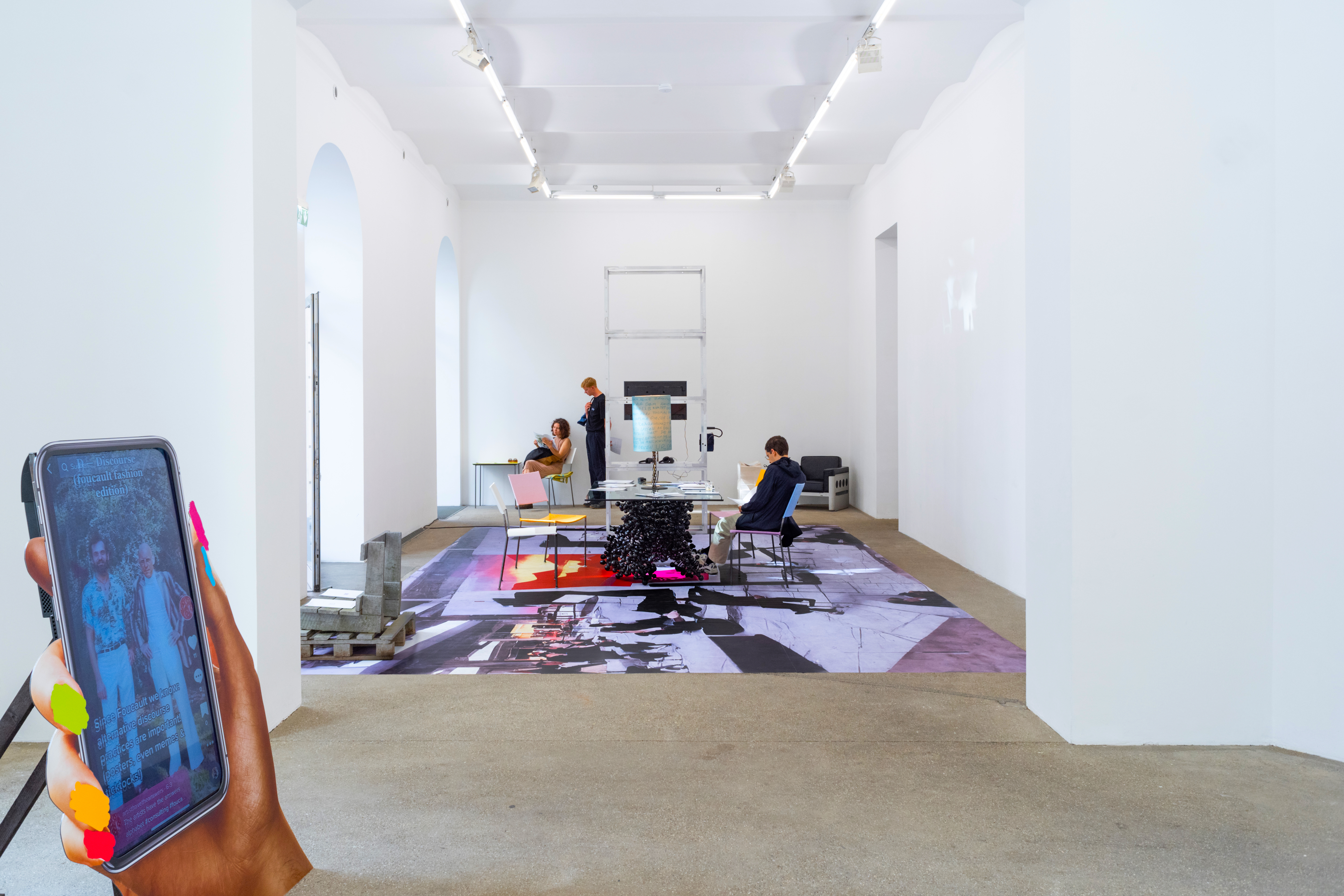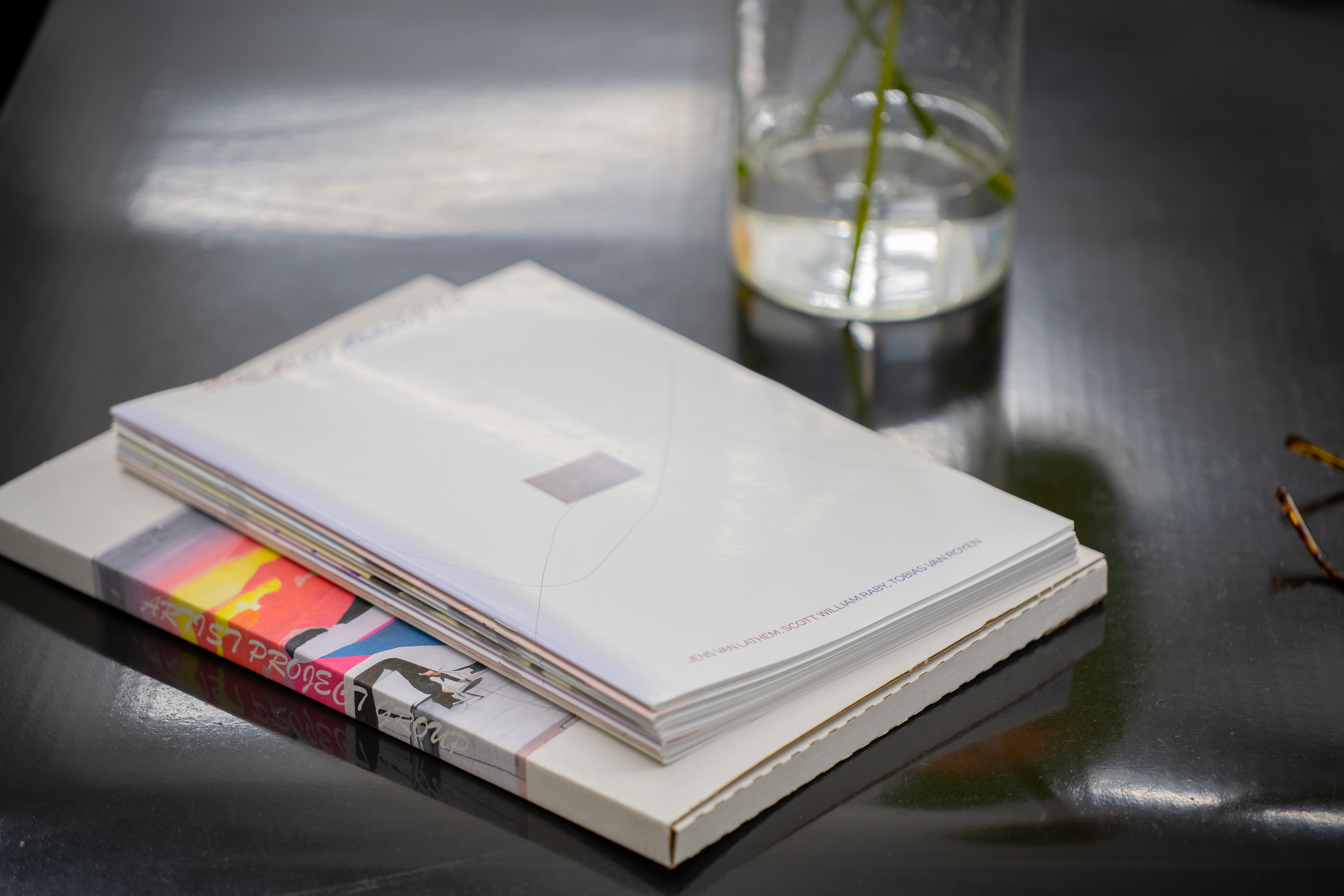@ Galerie Elisabeth & Klaus Thoman
curated_by Vienna 2022
8.9. - 9.10.2022
WITH: John M Armleder, Eglė Budvytytė, Juan Blanco (memeclassworldwide), Mateusz Dworczyk (memeclassworldwide), Thomas Feuerstein, Bernhard Garnicnig (Artist Project Group), Lukas Heistinger (Artist Project Group), Julia Haugeneder, Lucie Kolb, Ramona Kortyka (memeclassworldwide), Jens Van Lathem (Bureau of Analogies/TWIIID), Mary Maggic, Walter Pichler, Scott William Raby (Bureau of Analogies/f.eks), Tobias Van Royen (Bureau of Analogies/TWIIID), Jennifer Merlyn Scherler (memeclassworldwide), Miriam Simun, Paul Spendier, Peter Sandbichler, Parsa Sanjana Sajid, Seth Weiner, Franz West, Lois Weinberger


 Order dossiers online from Galerie Elisabeth & Klaus Thoman
Order dossiers online from Galerie Elisabeth & Klaus ThomanThe curatorial collective Artist Project Group (Bernhard Garnicnig, Lukas Heistinger, and Andrea Steves) interrogates phenomena of capitalism through curatorial and artistic methods, in an attempt to build platforms for resilient aesthetic and artistic practices. In our project for curated_by with Galerie Elisabeth & Klaus Thoman and within the framing of Kelet, we continue to investigate the capitalist overproduction of meaning, including the recuperation of crisis phenomena into the market, and ask “What Can Artists Do Now?”
Following the workshop "Artists Have The Answers?", which initiated dialogue between artists and consultants, and the online festival "What Would Artists Do?", which presented newly developed works as online services, the exhibition at Galerie Thoman further develops works from the vantage point of the Artist-as-Consultant and/or offered as services, and integrates these works into the context of a contemporary art gallery. Through the works, the exhibition troubles notions of audience, participant, material, and impact while presenting a wide landscape of the present phenomenon and epiphenomenon of capitalism. In presenting what these artists are doing now, the works connect to a multitude of current crises—both acute and wide-rangining—that are inherent in capitalism and continuously producing its resultant conditions and intensifications.
In the 90s, artists started to critically affirm their transforming role as service providers to institutions, yet their collective movement towards self-regulating their practice was often sidelined by discourses of critique and politics, putting an end to emancipatory initiatives to improve working conditions of artists. Andrea Fraser and Helmut Draxlers project “Services,” developed in the early 1990s, was specifically initiated with the intent of becoming a working group to develop an emancipated contractual basis for their evermore dematerialising and site-specific practice; however, their focus shifted during the project, though generating essential discussions in the process. Meanwhile, artist groups and collective incorporations such as Wochenklausur or Minerva Cueva’s Mejor Vida Corp. conceptualised work that was in service of socio-political problems, though not necessarily embracing, or downright rejecting, the terminology of “services'' in their work. Informed by the potential of these projects/initiatives, we have worked with a group of artists to develop services and directly address the lack of language and discourse in the discussion of artistic labor as services. Artist Project Group is interested in replacing the concept of innovation with practices of maintenance, that is, maintaining practices through crisis by developing projects in which artists extend their performative knowledge practices as services to institutions, organizations and businesses.
The Cybernetics-based model of business consultancy services is one of the most pervasive yet invisible global exports from the incipient Western Cold War information industry. Today, consultative industry continues its expansion into increasingly differentiated services, with its methods and services pervasively influencing decision making processes that govern public life. The Consultant and Consultancy as an industry are controversial and opaque figures, whose roles are as much subject of speculative capitalist lore as they are the representatives of a certain set of practices and methods. This implicit character is a ripe subject to be troubled by artists, who challenge numerous facets of traditional western thinking—principally the conventional orientation towards progress—by countering notions of competition with collective and participatory rituals, traditional technological development with divergent thought frameworks, and bringing in concepts like speculation and embodied knowledge.
Artists are purported to hold an important role in a changing society, yet their expertise is often undervalued, and their practices are rarely integrated with the processes where change happens. The constant expansion of capitalism continues even through war and crisis, an expansion that doesn’t exist outside of or separate from crisis and war, but rather intensifies through these periods: profiting and strengthening from them, feeding into them with weapons, solutions, technologies; that is, moving and shapeshifting into the gashes opened by war. Part of our position is acknowledging how artists can and should intervene in these ongoing logics. Offering services is a way of asking who is being served, and by whom.
Through the included works, which manifest in a range of consultancy services for organizations, and presented as printed Dossiers in the exhibition, Artist Project Group attempts to sketch the outlines for resilient artist practices. This conceptualization of resilience is broadly applicable, from economic fluctuations to institutional structures within the art market to the critical self-valuation of artists’ work during times of severe crisis. What Can Artists Do Now? That is, how can artistic practices be maintained, become resilient, or set the conditions for resistance and transformation?
In Scope of Work; Miriam Simun works with Glyphic Biotechnologies, a startup working on technologies for protein sequencing. The primary aim of Simun’s engagement is to develop a scope-of-work with the company, however, the overall work unfolds through an open Telegram channel, in which Simun catalogs her reflections and learning process: learning together with the audience of the work, a process in which the audience becomes an extension of the consultant and even a participant in the process through their interactions in the channel. Through the work, Simun opens up the question of what happens when the artist takes a position within the system of production (“artists as consultant”) as opposed to the position of independent, yet dependent on patronage (“artist in residence”)?
Simun’s work problematizes the conditions of technological innovation, as the artist traces both the stories of people and the flows of money and energy being moved for innovation. Biotechnology rearranges lives on multiple levels - molecular, interpersonal and political. Simun gestures towards a corporate unconscious: is a biotech company a site of cultural production? And how are dimensions of ethics, friendship, and privacy addressed or ignored amongst constraints of capitalist progress and innovation? What does an artist do amidst all this?
Alongside the expansion of capitalism, humans have developed extensive toxic and chemical substances—now emitting more than 250 billion tonnes of chemical substances a year in a cascade that harms people and environments all over the world—a condition of toxicity so grave that scientists have given Earth the official designation as a 'toxic planet'.
In the “Toxic Consultancy” workshop offered to organisations, Mary Maggic moves between modes of toxicity: from material and environmental to emotional and interpersonal, and guides participants in a toxic witch-hunt. A discursive exercise in scavenging and naming the poisons of daily life that will then be used to create new taxonomies. They ask: “Can our newly re-imagined taxonomies resist the violent process of othering? How do materialisms and subjectivities already resist being categorized?” The etymologies of “taxonomy" and “toxicity" are both derived from the Greek roots “tactics” and "toxikon” respectively for uses in times of war. Today, taxonomies and toxicities produce a different kind of violence that extends from material to subjective realms, from the geopolitical to the interpersonal. While we all live in a profoundly polluted world, we remain trapped in outdated notions of binary gender and normative bodies that ignore the malleability of life itself.
Mary Maggic’s contribution brings a reflection on the actually existing toxic relationships in environmental and interpersonal domains, and their relations within capitalism, the toxic fungal growth supported by conditions of capitalism: a system that pits individuals against each other, as system that overproduces toxicity in the physical environment as well as in social and interpersonal spheres.
In Dragging, Eglè Budvytytè approaches interpersonal relations from a slightly different lens: the power dynamics that emerge within our current political, corporate, and institutional systems. In her service offered as workshop, she extends an invitation to corporate and governmental organisations to host Dragging, a workshop that explores collective practices of slowness and intimacy, a practice which places an artist's performative (somatic) knowledge practice in the middle of invisible conflicts, directly seeking to sense and disrupt power structures.
The artist collective memeclassworldwide served as a rogue consultancy service to a German art school over several years by running a critical meme channel and self-organised seminars. Since graduating from school, they shifted their collective practice towards offering rogue consultancy services to other organisations and institutions. For this, they developed an online performance on TikTok, asking the question “What if institutions would ask their constituents for principles, terminologies, and instructions instead of demanding their assimilation?”. The channel and its included works represent the many problematic institutional relations that, taken together, constitute and represent invisible capitalist infrastructures supported by consultancy capitalism, characterizing a broad ecosystem of institutional relations and problems. memeclassworldwide resultantly intervenes into the methods and ideologies present in consultancy capitalism and teaches organisations to see the benefit of giving up control over images and language in a world of pluriversal thought.
Artists have long been offering their services for organizations, proposing site specific projects. In these proposals, artists usually describe what they can provide for the organization in exchange for a fee. With the artist becoming a de-facto service provider within and beyond the ever more event-oriented cultural industry, the organizations contracting these services, though, are challenged by creating the conditions necessary for the artwork to be developed.
In “What do we, as an organization, provide?”, Lucie Kolb and Bernhard Garnicnig propose an indeterminate list of assignments and conditions. Based on several years of scientific and artistic research, the dossier offers both practical and conceptual insights for any organization interested in becoming a host for artists’ services.
One of capitalism's most erosive effects is the ongoing replacement of social contracts with legal contracts. The power imbalance inherent to relations regulated by the legal system has its foundation in the access to legal counsel. When artists rely on trust and habits in their practice as service providers, they in fact rely on a legal system that is mostly unknown, and therefore inaccessible, to them. This is why the Bureau of Analogies has taken the first steps in finding and modeling relevant legal analogies to integrate within contracts for artists’ services. Specifically adjusted to the situation of a contemporary art gallery hosting an exhibition of artists’ services, the Bureau of Analogies project is based on research on the specific situation of artists’ working conditions in Vienna, and previous work which resulted in reformulating an artwork lending contract for an exhibition as a foster care agreement.
Parsa Sanjana Sajid offers insight into the ways in which the consultancy industry's methods and practices influence many aspects of life yet simultaneously fails to produce the effects it is claiming to have. The jargon of social impact, she writes, “produces nothing and too much all at the same time. It is action and inaction at the same time.” Drawing on examples from Myanmar and Bangladesh, Sajid traces the expansion of western consultancy capitalism into a new international market, while an ongoing refugee crisis continues to cause physical and psychological violence. She writes “The promise of social impact is wide and shallow. Social impact is a ready script and vision with which businesses, governments, nonprofits, think tanks have armed themselves. Often consultants “help” in fulfilling that promise. Promises of change and results, quantifiable evaluations and actionable terms, efficiency and process improvements, acceleration and deceleration all tied to the rhythms of capitalism. Consultants are experts at finding a seat at the table to turn a concept into a cliché – disruption, innovation, thinking outside the box. A stake on the street would be more promising.”
The presentation of What Can Artists Do Now? is in itself a site-specific service designed for a contemporary art gallery. Applying the concept of maintenance to the cultural context of Galerie Elisabeth and Klaus Thoman, and addressing the need for functional visual surfaces for a festival, Artist Project Group recasts the gallery as an interface for services. Furniture by artists represented by the gallery is placed to serve as an environment for study and conversation. It is an embodiment of a shift taking place: the inclusion of increasingly dematerialised applied arts practices for a knowledge industry among artworks that also function as furniture, themselves embodying the institutionalized distinction between purpose and pleasure.